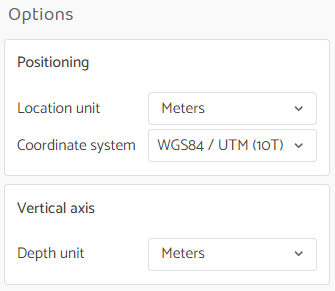Appearance
Geo-referencing projects
Geolitix has been designed to support projects in a variety of coordinate systems. Simple Cartesian coordinates using a local grid are useful for small projects or rebar mapping. Cartesian coordinate (x,y) grids can easily be georeferenced by providing Geolitix with a corner coordinate and a rotation angle, or two corner coordinates.
However, for larger projects and for those involving utilities detection, georeferenced data are critical. Generally, GNSS receivers store location information in Latitude/Longitude coordinates. By default, Geolitix reads in all GNSS or total station positioning information associated with GPR datasets and converts the GNSS NMEA strings to UTM WGS84 positions.
It is often required to work on a project within a specific national or regional coordinate system. There are many tools available to convert UTM WGS84 coordinates to the hundreds of possible national grids. However, it is crucial to note that such tools are often inaccurate up to multiple metres, which could produce inaccurate final results.
Geolitix implements support for national and regional grids on a case-by-case basis and only uses verified government transformation parameters to ensure the greatest possible accuracy. These are implemented on a user-requested basis. The project coordinate system is defined by clicking the Options icon on the sidebar.

From this menu, you can select the default planar measurement units (meters, centimeters, millimeters, feet, or inches) and the default vertical measurement units.
The project coordinate system defines the coordinates for your workspace as well as all files exported.
Importing specific layer types reveals a dialog box with which you can select if the new data is in the project coordinate system or is in a different coordinate system and must be converted. For example, a project could be defined in OSGB coordinates for the United Kingdom and all work on the platform as well as all exports will be in OSGB. However, imported GPR may be in WGS84 coordinates. Each imported layer can be assigned to be the project coordinate system or a different coordinate system.